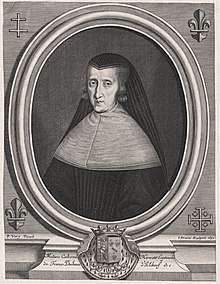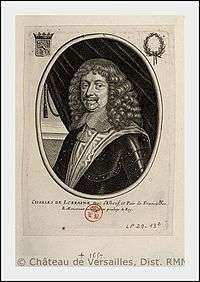Catherine Henriette de Bourbon
Catherine Henriette de Bourbon (11 November 1596 – 20 June 1663) was an illegitimate daughter of King Henry IV of France and his long-term maîtresse en titre Gabrielle d'Estrées. She was declared legitimate on 17 November 1596 at the Abbey of St. Ouen in Rouen and married into the Princely House of Guise.
| Catherine Henriette de Bourbon | |||||
|---|---|---|---|---|---|
| Légitimée de France Duchess of Elbeuf | |||||
 Catherine in 1659 as a widow, by P Vary | |||||
| Born | 11 November 1596 Rouen, France | ||||
| Died | 20 June 1663 (aged 67) Hôtel d'Elboeuf, Paris, France | ||||
| Spouse | Charles II, Duke of Elbeuf | ||||
| Issue Detail | Charles III, Duke of Elbeuf François Louis, Count of Harcourt François Marie, Prince of Lillebonne | ||||
| |||||
| House | Bourbon | ||||
| Father | Henry IV of France | ||||
| Mother | Gabrielle d'Estrées | ||||
Early years
Born on 11 November 1596 in Rouen, France, she was baptised on 17 November 1596. At her birth, Queen Elizabeth I of England sent a special ambassador who also proposed a new treaty between the two nations. Then, surprising everyone, Spain attacked Amiens. One of the first things Catherine Henriette's mother Gabrielle did was to ask the people of France to contribute financially to the war effort while she herself pawned her jewellery; in doing so she raised a substantial fortune.
In her youth, she was known as Mademoiselle de Vendôme, derived from the Duchy of Vendôme which had been in possession of the House of Bourbon since 1393. Her older brother, César, was legitimised in 1595 and given the title of Duke of Vendôme. César would later scheme against the crown against Cardinal Richelieu in the Fronde with their younger half-brother Gaston. Her youngest full sibling, Alexandre, was born in 1598 and died in 1629.
When she was just three, her 26‑year‑old mother died of an attack of eclampsia after giving birth to a stillborn child. As a result of her mother's death, Catherine Henriette inherited her wealth in her own right. Her mother's duchy, Beaufort, was given to her older brother, César.
In 1610, her father was assassinated outside the Louvre Palace on 19 May. This left her eight-year-old half-brother Louis XIII the new king, with a regency under the power of his mother Marie de' Medici, who hated the royal bastards.
Marriage
It was discussed that she should marry Henry, Prince of Condé, but the idea was dropped.

Her husband would be the Duke of Elbeuf, born Charles de Lorraine and a member of the House of Guise. The House of Guise was a cadet branch of the Dukes of Lorraine which were one of the most powerful families in France. The 25‑year‑old Mademoiselle de Vendôme married Charles at the Palais du Louvre in Paris on 20 June 1619. The groom was seven months younger than the bride. Her younger half-sister Christine Marie of France had married there also in February the same year to Prince Victor Amadeus of Savoy, future Duke of Savoy.
The dowry given to the House of Guise was the large sum of 1.3 million livres and included pensions as well. Most of this money was spent and re-mortgaged for various reasons including a failed lawsuit against her brother César.[1]
As Catherine Henriette was marrying into the House of Guise, she took on the style of Highness, the Guises being foreign princes at court. After her marriage, she was known as the Légitimée-duchesse. She used to sign documents as C H. L de France – Catherine Henriette. Légitimée de France.
Her marriage produced six children, three of whom would have issue. Her husband died in Paris at the Hôtel d'Elboeuf, the family town house. Catherine Henriette remained a widow for six years until her own death in 1663.
Issue
- Charles III of Elbeuf (1620–4 May 1692)
- Henri (1622–3 April 1648) never married; Abbot of Hombieres
- François Louis, Count of Harcourt (1623–27 June 1694), married and had issue;
- François Marie, Prince of Lillebonne (4 April 1624 – 19 January 1694); married and had issue
- Catherine (1626–1645)
- Marie Marguerite (1629–7 August 1679) known as Mademoiselle d'Elboeuf; died unmarried and childless
References and notes
- Spangler. Jonathan, The Society of Princes; the Lorraine-Guise and the conservation of power and wealth in the Seventeenth Century, Ashgate, London, 2009, p.154
